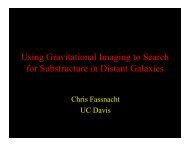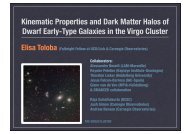DPS 42nd Meeting Abs..
DPS 42nd Meeting Abs..
DPS 42nd Meeting Abs..
- No tags were found...
Create successful ePaper yourself
Turn your PDF publications into a flip-book with our unique Google optimized e-Paper software.
the HIPPAROCS satellite, it appears that the number of injected comets is less than 20% of the total flux for semi-major axis smaller than 25 000 AU.On the contrary, the stars which could be observed by the future GAIA mission will allow to obtain more than 80% of the total flux forsemi-major axis smaller than 40 000 AU and more than 90% for semi-major axis smaller than 25 000 AU.In conclusion, because the stellar perturbaons allow to inject comet at smaller semi-major axis than with only the des, our view of the Oort cloud size andpopulaon may change.We have also shown that it is hopeless to perform a backward integraon over one orbital period of the known "new comets" in order to esmate this size sinceour knowledge of the stellar neighborhood of the Sun is sll too incomplete. However, future spaal mission like GAIA may fill this gap and allow us to performsuch a study.MF is grateful to PNP 2010 for financial support.05.06: Capture of the Sun's Oort Cloud from Stars in its Birth ClusterAuthor Block: Harold F. Levison 1 , M. Duncan 2 , R. Brasser 3 , D. Kaufmann 11 Southwest Research Inst., 2 Queen's University, Canada, 3 Nice Observatory, France.Presentaon Time: 10/4/2010 11:20 AM - 11:30 AMLocaon: Ballroom E<strong>Abs</strong>tract: Oort cloud comets are currently believed to have formed in the Sun's proto-planetary disk, and to have been ejected to large heliocentric orbits by thegiant planets. Detailed models of this process fail to reproduce all of the available observaonal constraints, however. In parcular, the Oort cloud appears to besignificantly more populous than the models predict. Here we present numerical simulaons that show that the Oort cloud could have been captured from otherstars while the Sun was in its birth cluster. Our results imply that >~90% of the Oort cloud comets that we have seen are from the proto-planetary disks of otherstars. This includes some of the most famous comets in history, including 1P/Halley and C/1995 O1 (Hale-Bopp). We thank NASA's Astrobiology Inst, and Originsand OPR programs for support.05.07: Detecon of Nongravitaonal Acceleraons on Comet 133P/Elst-PizarroAuthor Block: Steven R. Chesley 1 , H. Kaluna 2 , J. Kleyna 2 , K. Meech 2 , J. Pichová 2 , D. Yeomans 11 JPL/Caltech, 2 Inst. for Astronomy, Univ. Hawaii.Presentaon Time: 10/4/2010 11:30 AM - 11:40 AMLocaon: Ballroom E<strong>Abs</strong>tract: Comet 133P/Elst-Pizarro is the best observed of the main belt comets, with astrometric measurements now spanning more than 30 years and for thisreason is so far the only main belt comet confirmed to have recurring periods of acvity. Here we report the detecon and measurement of nongravitaonalacceleraons acng on the nucleus of Elst-Pizarro.Using the so-called g(r) formalism of Marsden et al. [1] we esmate the radial and normal nongravitaonal parameters of Elst-Pizarro as, respecvely,A1=12.6±4.1 and A3=7.5±6.3 in units of 10 -10 AU/d 2 . Stated uncertaines are formal. The observaonal data do not reveal stascally significant transverseacceleraons (i.e., A2). The stascal significance of the out-of-plane acceleraon is poor, and should be interpreted merely as an indicaon that theacceleraons are likely posive, suggesng a possible predominance of southern hemisphere acvity in the case of direct rotaon. On the other hand, the 3-sigma significance of the radial acceleraon gives good confidence in the esmate, and indeed the esmated value of A1 is stable across a range of fit spans anddata treatments.The above parameters imply a peak acceleraon of 2.5×10 -10 m/s 2 at perihelion. Assuming reasonable values for nucleus mass and gas velocity leads to a massflow rate roughly of order 10 kg/s. However, the applicability of the Marsden et al. model is dubious in this case where there is good evidence that the outgassingis governed primarily by seasonal factors rather than the simple g(r) funcon [2]. Thus the out-gassing could be considerably more spread in me andhave a lower maximum, especially if it takes place far from perihelion. The ulity of alternate out-gassing models will be considered.Refs: [1] Marsden et al., AJ 78, 211--225, 1973. [2] Hsieh et al., AJ 127, 2997--3017, 2004.05.08: Temporal Evoluon of Water and Dust in Comet 9P/Tempel 1 aer the Deep Impact Event, as Observed from SpitzerAuthor Block: Adeline Gicquel 1 , D. Bockelée-Morvan 1 , M. S. Kelley 2 , C. E. Woodward 3 , D. H. Wooden 41 Observatoire De Paris, France, 2 Department of Astronomy, University of Maryland, 3 Department of Astronomy,School of Physics and Astronomy, 4 NASA AmesResearch Center, Space Science Division.Presentaon Time: 10/4/2010 11:40 AM - 11:50 AMLocaon: Ballroom E<strong>Abs</strong>tract: The Deep Impact (DI) spacecra encountered comet 9P/Tempel 1 on July 4th, 2005. The spacecra released an impactor that collided with the cometnucleus and excavated (possibly unprocessed) cometary material in a prominent ejecta plume. Spectral maps covering 20'' x 67'' (1.85''/pixel) were acquired withthe IRS instrument on the Spitzer Space Telescope at different mes around the DI event: twice before impact (TI-41.3hrs and TI-22.9hrs) and twelve mes aerimpact (between TI+0.67hrs and TI+1027hrs). These IRS observaons are stored in the Spitzer data archive and presented by Lisse et al. (2006, Science 313, 635).We present the interpretaon of 5.2-7.6 micrometer spectra obtained in the second order of the short-wavelength module (SL2). To reduce the contribuon ofarfacts in the spectra, 5x5 pixel extracon apertures (9.25''x9.25'') were used. The underlying connuum in the spectra provides informaon on the grain sizedistribuon and color temperature of the dust ejecta. In order to determine the grain size distribuon, we assumed that ejecta consist of a composion of bothamorphous carbon and silicates. The grains are assumed to be spherical with sizes in range from 0.1 to 100 micrometers. We used the Mie theory to calculate theopcal properes of each material and the temperature of the grain. We constrained the grain size distribuon and velocies from the spectra and the temporalevoluon of the dust flux. The dust mass and dust/gas rao in the ejecta cloud are also derived and compared with other values published in the literature.05.09: Crystalline Water Ice In Outburst Comet P/2010 H2Author Block: Bin Yang 1 , G. Sarid 11 Astrobiology Instute, Univ. of Hawaii.Presentaon Time: 10/4/2010 11:50 AM - 12:00 PMLocaon: Ballroom E<strong>Abs</strong>tract.<strong>Abs</strong>tract: The Quasi-Hilda comet P/2010 H2 (Vales) underwent a remarkable outburst on UT April 16, 2010. The brightness of this object increased by afactor of 1000 in less than 15 hours. Near-infrared (0.8 to 2.5 micron) spectroscopy of this new comet was performed using the 3.0-m NASA Infrared TelescopeFacility atop Mauna Kea on UT April 20 and 22, 2010. Two broad absorpon bands were detected in the reflectance spectra of Vales, centered at 1.5 and 2.0micron at depths of 4% and 8% of the connuum, respecvely. These features, which were detected on the both nights, are consistent with abundant water icegrains in the central coma. Moreover, a narrow absorpon feature was observed at 1.65 micron, indicang the presence of crystalline ice. We will present the NIRspectra of comet Vales and the best-fit synthec models. We will also discuss a dynamical analysis which constrains the lifeme and the likely source regions ofthis new outburst comet. This was supported by the Naonal Aeronaucs and Space Administraon through the NASA Astrobiology Instute under Cooperave





